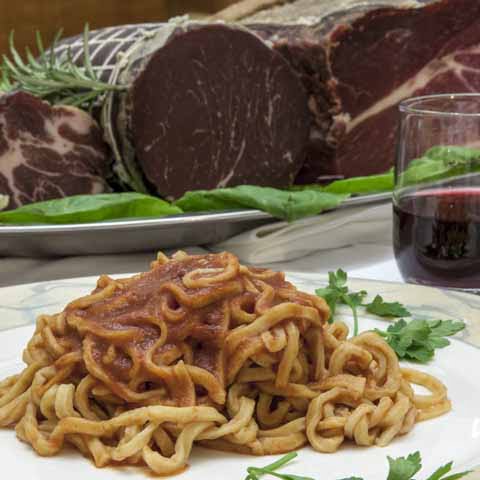Much like the rest of Italy, Umbrian cuisine is central to the culture and daily life of locals. Often, family and friends can spend hours enjoying long meals together, enjoying course after course of foods made from seasonal produce, meats, olive oil, and mushrooms. Similar to Tuscan cuisine, dishes in Umbria are known for their simplistic recipes which highlight the natural flavors of local ingredients. While meals in Umbria are not as reliant on bread and olive oil as that of Tuscany, both cuisines have roots in peasant culture, in which chefs waste nothing during food preparation and make the most out of limited ingredients. As a result, the cuisine of Umbria is rustic and simple, yet very flavorful.
Key characteristics of Umbrian meals are cured meats such as cold cuts, delicious varieties of sweet desserts, local wines such as Orvieto Classico, pecorino cheese, and white and black truffles – delicacies that have made the region famous worldwide. Though landlocked, Umbrian food also often contains seafood from Lake Trasimeno.
APPETIZER/ENTRÉE
To begin a meal in Umbria, wooden platters covered with a variety of dishes are typically served, including bruschetta, grilled vegetables, and cured meats.
One of the most popular appetizers highlights the region’s most precious ingredient – truffles. Crostini alla norcina o al tartufo consists of sliced, grilled bread brushed with olive oil and topped with truffles or truffle paste made with chicken livers. Another common dish is frittate – a type of omelet flavored with vegetables, cheese, herbs, or truffles.
FIRST COURSE
As is common with first courses throughout Italy, pasta is the highlight of first courses in Umbria. Typical dishes include pappardelle alla lepre – pasta served with a game sauce, such as hare – umbricelli in salsa di Trasimeno – long pasta served with a delicate sauce made of white wine, tomatoes, spices, and fresh perch fish from Lake Trasimeno. One of the most unique pastas of the region is strangozzi. Only made in Umbria, it is wheat-based and shaped like long shoelaces and often served alongside black truffles.
SECOND COURSE
Italian cuisine second courses are traditionally meat-based. In Umbria, dishes are typically comprised of game, cold cuts, hen, and fish. Popular dishes include colombaccio selvatico – slow roasted pigeon, gallina ubriaca – hen dipped in red wine, and tegamaccio – fish stew. One second course dish that displays the peasant cuisine tradition of the region is torello alla perugina, which utilizes leftover broth and meats.
Meats and cold cuts in Umbria often come from the local norcineria – a special butcher shop which specializes in cured meats. One of the most famous is a special variety of pork, which is hailed for a traditional preparation that dates to Roman times and is considered a secret art. The pigs are raised on a diet consisting mainly of acorns, which influences the taste of the meat and positively effects the animal’s quality of life. Meats from a norcino are known for their delicious, melt-in-your-mouth flavor.
SIDES
To accompany traditional Umbrian meals are a variety of side dishes, often consisting of vegetables or legumes. Some of the most common sides include:
Also served alongside meals in Umbria are cheeses, particularly sheep’s milk varieties which are famous exports of the region. Pecorino di Norcia is the best representation of quality Umbrian cheese. Made of sheep’s milk, it has a characteristic salty taste with an intense flavor and crumbly texture.
DESSERTS
Umbria is known for its regional desserts. Local towns all have various recipes for sweet dishes that are usually served at special holidays, events, and celebrations. On par with other recipes in Umbrian cuisine, desserts of this region often use the same simple and local ingredients in various ways to create different dishes.
Some traditional Umbrian desserts include torciglione – a savory pastry usually served at Christmastime, made with almonds, sugar, egg whites and stinchetti – dry biscuits made of almond, honey, cinnamon, vanilla, lemon, and egg whites. Another variety of biscuits popular in Umbria are pinoccate – similar to stinchetti, except made with pine nuts and cocoa.
Umbria’s sweet side is most well-known by its chocolate. The Perugina Chocolate Factory creates an infamous variety of chocolate called Bacio, which translates to “Kiss.” It is a celebrated symbol of romance and a popular gift alongside flowers for Valentine’s Day. The region is a must-visit during the European Chocolate Festival, held each year in Perugia. This celebration of chocolate features artisan chocolate varieties and handmade treats.
STREET FOODS
When walking throughout the towns of Umbria, travelers should make time to enjoy some of the region’s traditional street foods. Porchetta is known as the king of Umbrian street food. Served from street carts or food trucks, it is a seasoned, roasted pork with a unique flavor. Another popular street food is torta al testo – a version of focaccia made simply with flour, water, and salt and often filled with vegetables or meat, such as sausage or porchetta.
WINE
Umbria, known as the “green heart of Italy,” features vineyards throughout the entire region and boasts 13 DOC wines. Known primarily as a white wine region, Orvieto is the area’s most famous variety. It has been produced in the area for thousands of years and is known for its fruitiness while still being crisp and dry.
Recently, Umbria has seen a rise in red wine production. Some of the most unique varieties available are Montefalco Sagrantino – considered to be one of the most tannic reds available, Montefalco Rosso – a ruby Sangiovese, and Vernacccia di Cannara – a red dessert wine. Another popular dessert wine is Vin Santo, known for its beautiful golden color.
Umbria Region of Italy
Cities of Umbria


